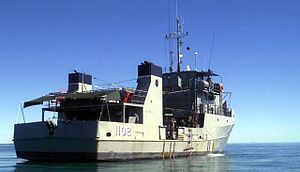Craft of Opportunity Program

The Craft of Opportunity Program (COOP) was a Royal Australian Navy (RAN) acquisition program intended to supplement the navy's mine warfare capability with civilian vessels that could be quickly converted into minesweepers. Vessels acquired under COOP were not commissioned into the RAN, and instead operated with the prefix "MSA" (Minesweeper Auxiliary).
Acquisitions
COOP was initiated in 1985, to cover the gap in
Six vessels were purchased under COOP:
End of the program

By 2012, most of the vessels have been sold or returned to their owners.[7] Bandicoot and Wallaroo have not been operated as minesweepers since 2010, but were retained until 2014 to provide berthing support for nuclear-powered warships.[8][9] The drones have been non-operational since 2007, and are due to be replaced by 2013.[10]
Citations
- ^ a b Jones, in Stevens (ed.), The Royal Australian Navy, p. 252
- ^ a b c Gillett, Australia's Navy, p. 44
- ^ a b Wertheim (ed.), The Naval Institute Guide to Combat Fleets of the World, p. 23
- ^ Spurling, in Stevens (ed.), The Royal Australian Navy, p. 275
- ^ Wertheim (ed.), The Naval Institute Guide to Combat Fleets of the World, pp. 23–4
- ^ Wertheim (ed.), The Naval Institute Guide to Combat Fleets of the World, p. 24
- ^ Gillett, Australia's Navy, pp. 42–5
- ^ Gillett, Australia's Navy, p. 45
- ^ Saunders & Philpott (eds.), IHS Jane's Fighting Ships 2015–2016, p. 25
- ^ Gillett, Australia's Navy, p. 42
References
- Gillett, Ross (2012). Australia's Navy: Today and Tomorrow. Vol. Part 1. Topmill.
- Saunders, Stephen; Philpott, Tom, eds. (7 August 2015). IHS Jane's Fighting Ships 2015-2016. OCLC 919022075.
- Stevens, David, ed. (2001). The Royal Australian Navy. The Australian Centenary History of Defence (vol III). South Melbourne, VIC: Oxford University Press. OCLC 50418095.
- Jones, Peter. "A Period of Change and Uncertainty". The Royal Australian Navy.
- Spurling, Kathryn. "The Era of Defence Reform". The Royal Australian Navy.
- Wertheim, Eric, ed. (2007). The Naval Institute Guide to Combat Fleets of the World: Their Ships, Aircraft, and Systems (15th ed.). Annapolis, MD: Naval Institute Press. OCLC 140283156.
